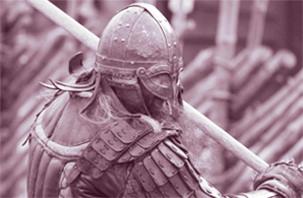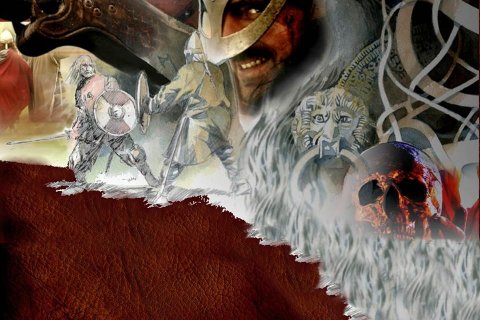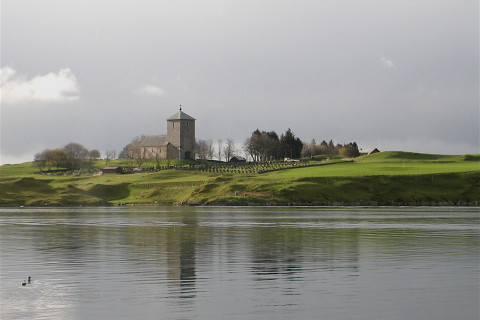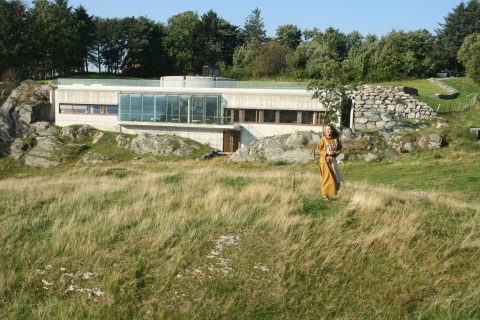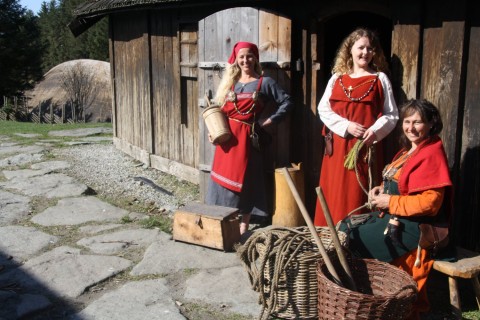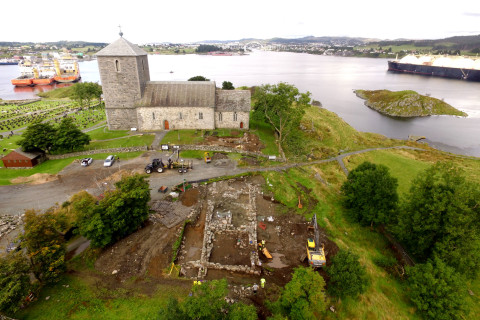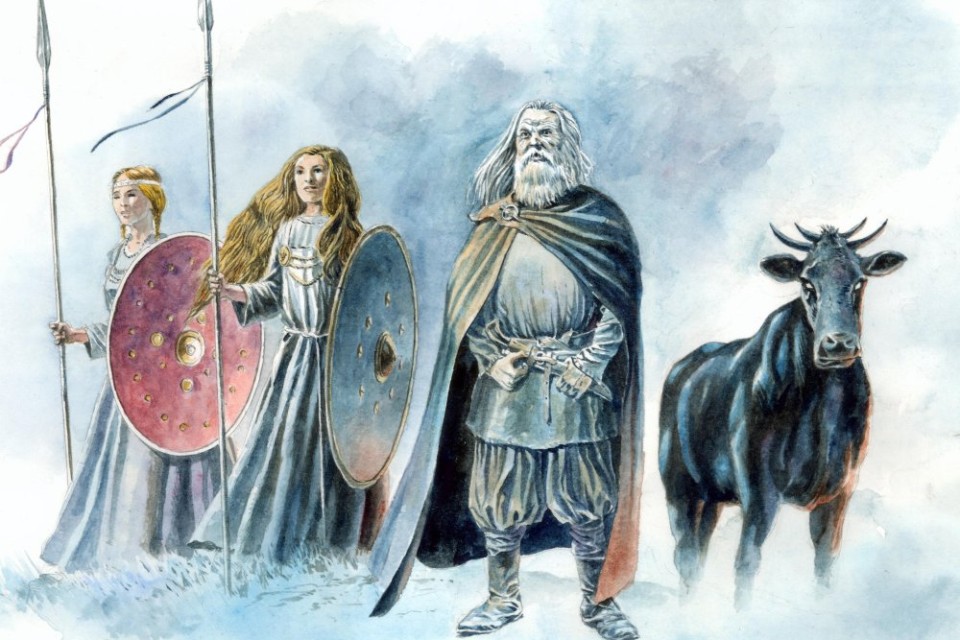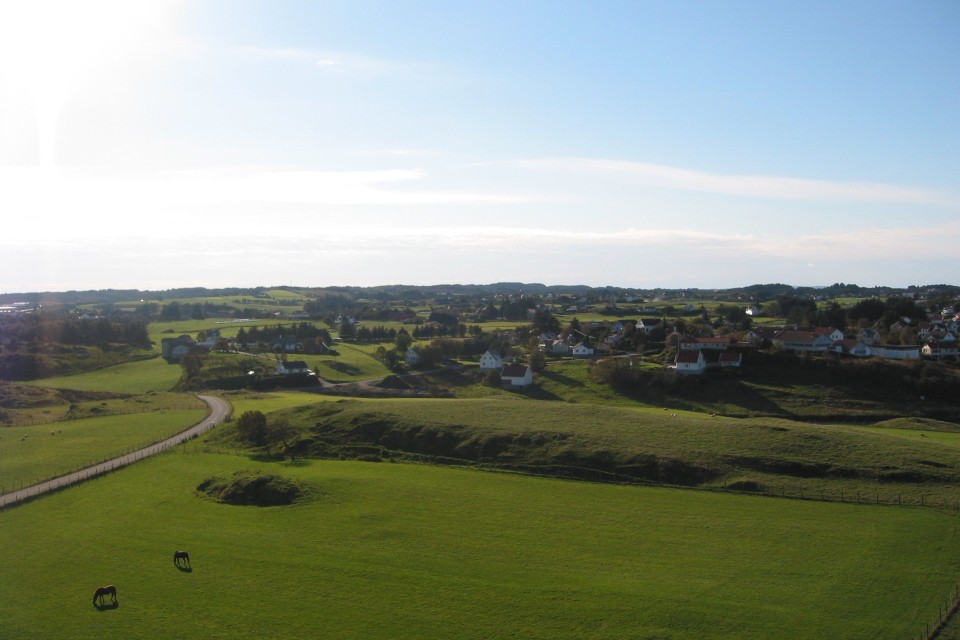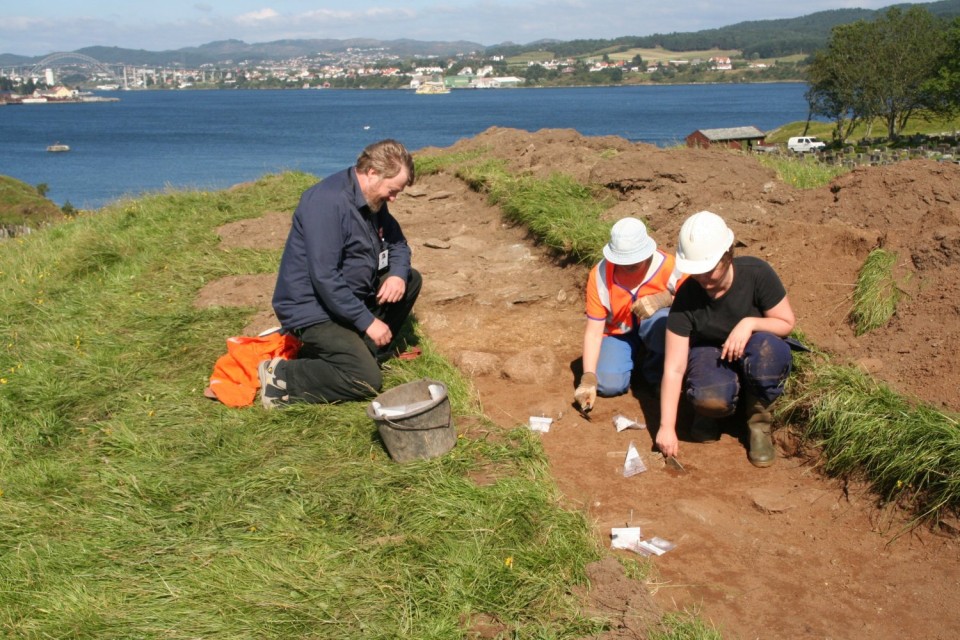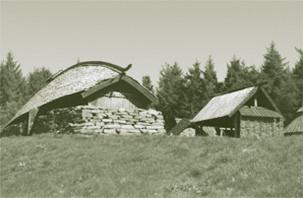Augvald
Text: Marit Synnøve Vea
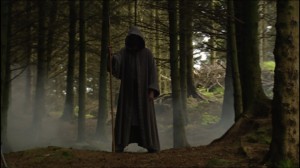
According to Snorri Odin came to Avaldsnes around 998 AD to tell King Olav Tryggvason stories about King Augvald. (Photo Gunnar Strøm)
Avaldsnes is primarily known as the royal seat of Harald Fairhair, but it was the legendary King Augvald who gave his name to the place. He is believed to have lived at some time during the 7th century. The Old Norse name for Augvald was Ogvaldr. His name may mean “the ruler held in awe by the people or simply ” The Ruler of the Coast”. (from “ogd”, meaning “stretch of coast”). The ancient genealogies tell us that Augvald could trace his family line back to divine beings, and he became the ancestor of many kings.
In some written sources, the Norse phrase «vordr véstalls” or ”ves valdr” (the one who watches over and rules over the sacred place) is used to denote a king. (Näsström 2001:67).
Stories about King Augvald appear in several of the old sagas; the best known story is Snorre’s tale in the saga of Olav Tryvggvason, where we learn that Odin himself came to Avaldsnes and told King Olav the story of Augvald. An old legend from Karmøy tells about the strife between KING FERKING AND KING AUGVALD
Resumé of the story of King Augvald
King Augvald was the son of Rognvald, the son of Rugalf, the son of Gard Agde, who in turn was the son of Nor, who came from the island of Gotland. In the beginning, Augvald’s main royal seat was located at Roga in Jøsursheid, between the counties of Rogaland and Telemark. He was then only king of a territory stretching from Jøsurfjord in Hjelmeland to Brunkeberg and Fyresdal.
After a number of successful naval battles, he managed to conquer the land of the Holmryger, drove out their rulers and settled at the best possible location on the island of Kormt. This place – Augvaldsnes – has been named after King Augvald ever since.
Once when Augvald was hunting with his men, his queen gave borth to a son whom they called Jøsur, who was brought uo by Gunnvanld Stordajarl.
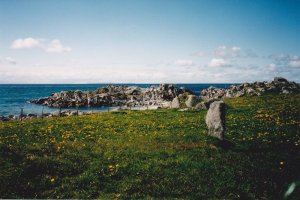
According to the legend, Augvald’s two daugthers, the “shield maidens”. were buried at Stava where you still can see their memorial stones. (Photo Marit S. Vea)
King Augvald was a belligerent man who frequently went on Viking raids to foreign lands and acquired much wealth and standing. Augvald believed that his sacred cow gave him victory and that her milk gave him vitality and strength. An ancient legend from Karmøy relates that Augvald had several daughters, two of whom were shield maidens who fought alongside their father in all his battles. (Read more about King Augvald here: Forgotten Royal Families)
“The descendent of gods and the ancestor of kings”
Augvald is called “the descendent of gods and the ancestor of kings”. If the Old Norse genealogical myths are to be believed, Augvald could trace his ancestors all the way back to the very first Jotun giant called Ymir or Fornjot, who was created at the same time as the original cow Audhumla, when fire and ice came together to create the world. Augvald was the ancestor of many kings who were known to have ruled at Avaldsnes after him.
Family tree of King Augvald
|
Fornjot (Ymir) |
| Ægir – |
Kåre (Vind)- Loge |
|
Frost |
|
Snø |
|
Thorre |
| Gor – |
Nor – Goe |
|
Gard Agde |
|
Rugalf |
|
Rognvald |
|
Augvald(ca 600 e.Kr.?) |
|
Jøsur |
|
Hjør Jøsurson |
|
Hjørleiv den kvinnekjære |
|
Halv |
|
Hjør Halvson |
|
(Flein Hjørson) |
|
(Hjør Fleinson) |
|
Geirmund og Håmund Heljarskinn |

“ Cow’s mound”, just above Nordvegen History Center, has received its name because people believed Augvald’s sacred cow was buried here. The burial mound is also called “Cellar mound” (Photo M. S. Vea)
Augvald worshipped a sacred cow
Augvald owned a sacred cow that he worshipped. He took the cow with him wherever he went. Some say that his cow was called Audhumla and wore a golden yoke around her neck. In any case, Augvald believed that the cow gave him victory in battle and that her milk endowed him with vitality and strength.
When Odin came to Avaldsnes to tell the story of King Augvald
According to Snorre, Odin himself came to Avaldsnes one Christmas evening a thousand years ago and told Olav Tryggvason the story of King Augvald and his sacred cow. Another historian, Odd Munk, who lived towards the end of the 12th century, writes that after the meeting with Odin, Olav went out and dug up two of the burial mounds at Avaldsnes. In one of them he found bones from Augvald’s sacred cow and in the other, he found King Augvald’s bones.
Was Augvald buried at Kongshaugen (King’s Hill/Mound)?
Several of the burial mounds to be found at Avaldsnes have been called Augvald’s Mound or the King’s Mound. Tradition has it that the ridge called Kongshaugen (King’s Hill) that lies southwest of St Olav’s Church was given this name because King Augvald was buried here. However, no burial mound was known on this ridge.
In the summer of 2005, the Archaeological Museum carried out a number of trial excavations at Kongshaugen. In addition to several other graves and burial constructions, the archeologists also discovered an unopened burial mound that appears to date from the Age of Migration – could it be that Augvald lies buried here?
A sacred cow in Kuhaugen – Kjellarhaugen (Cow’s Mound – Cellar Mound)
Again according to tradition, Augvald’s cow was buried in the Cow’s Mound. Around the year 1800, a tenant farmer built a potato cellar in this mound, hence its alternative name of Cellar Mound. The story goes that when the farmer dug out the potato cellar, he found “the golden collar of Augvald’s sacred cow”, became extremely rich and bought himself a farm at Nedstrand.
After this, it was believed that the Cow’s Mound was completely destroyed, but in the summer of 2000, an examination shaft was inserted into the mound. The archaeologists then found what appeared to be a partly intact burial chamber, and the work was halted. In 2012, the Royal Manor Project built a new, small examination shaft into the mound. It was then discovered that the Cow’s Mound was originally built in the Bronze Age, but graves were most probably also laid in the mound during the Iron Age.
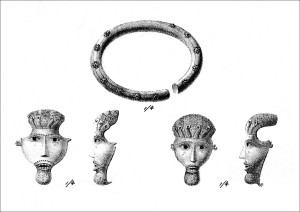
Copper alloy facemasks found at Avaldsnes in c. 1800. Drawing by Lyder Sagen in 1812. (Photo: Bergen Museum )
Researchers believe that it was in this mound that two bronze masks and a gilded arm ring were found in about 1800. The findings were sent to “The Antiquarian Commission in Copenhagen”, but are now most probably lost to posterity.
However, since accurate drawings were made of the findings and they are mentioned in a number of written sources, we know quite a lot about the masks and the neck ring. Perhaps it was this very ring that was described in the past as “The collar of Augvald’s sacred cow”? But whether the cow itself was buried here remains an unanswered question. (See To ansiktsmasker og ein ring frå Avaldsnes i Rogaland
Augvald’s kingdom in Rogaland and Hordaland
The ancient sources tell of how Augvald, a non-local, settled down at Avaldsnes on the island of Kormt, the largest island in the Ryfylke region. A relatively unknown text, “the Archive for the Department of Education and Information” by Dr. P. Hansen, written around 1800 AD”, describes the geographic extent of Augvald’s kingdom. Dr. Hansen chooses not to name his sources, though he does refer to Tormod Torfæus in areas of his text. He also credits pastor Krogh from Skudenes for the useful historical and topographical information he provided. It is clear from the tone of the text that a large proportion of his material is drawn from the legend of Halv. Dr. Hansen writes:
He (Augvald) has since expanded his dominion over the remainder of mainland Rogaland, after having banished Karmøy’s and the other islands rulers from their estates, as if it were his desire to continually be either at war or on raiding expeditions. On both sides of the island as well as his place of residence, he controlled important outlets to the North Sea, such as: Hinderager-Vaagen and Vikingstad-Vaagen, outside which the Faroes and many other islands lie. (…)
Mosterøen and Storøen also belonged to Augvald’s kingdom, as did the greater part of Fieldberg, namely Vige or Vide Sogn, Aulands Sogn, Æthne, Vallerstrand and Sveens Sogne. Gundvold, who was responsible for the upbringing of his son Josur, was named Earl of the northern regions of these Hordaland provinces.
Dr. Hansen recounts the narrative from the Saga of Half and His Heroes of how Jøsur Augvaldson was slain by Vikar while attending a banquet in Kvinnherrad:
… and all of the males who had taken to arms for Jøsur were killed; and since none other than the women of this bitter enemy were spared, this part of the country was given the name Qvina, or Qvindherred. Vikar was later deprived of these areas by Jøsur’s son Hior who inherited the throne of Rogaland after the death of his father. Hior was a wise and powerful sovereign, praised for his work in reuniting Hordaland and Rogaland.
Can we trace Augvald’s kingdom through archaeology?
Arnfrid Opedal has looked at the extent of the 8th century kingdom in Rogaland and Hordaland that was ruled by the king buried in the Storhaug ship. She has compared this area with the extent of king Augvald’s kingdom, as it is described in written sources. She finds a remarkable coincidence. According to written sources, this is also the area that royal families in Western Norway fight over in the generations to come after Augvald.
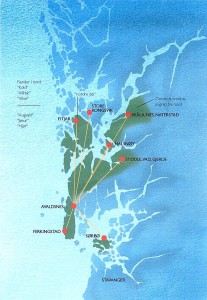 Augvald’s kingdom. (Map from A. Opedal: ‘Skipsgravene på Karmøy. Kongemakt og kongerike i en førstatlig tid”. (Ill. S. Iversen) |
Green colour: Marks areas mentioned in connection with king Augvald according to “The Archive for the Department of Education and Information” by Dr. P. Hansen. 1800.
The geographical determination of the areas is based on “Skipreideinndelingen etter skatte-matrikkelen fra 1647″.
Red dots: Mark sites connected with the realm of 700s.
|
Read more about King Augvald: FORGOTTEN ROYAL FAMILIES
Main photos/illustrations: Dag Frognes, Ørjan Iversen, Marit Synnøve Vea, O. Værings Eftf.
Back

